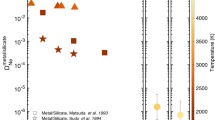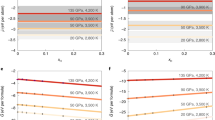Abstract
Noble-gas geochemistry is an important tool for understanding planetary processes from accretion to mantle dynamics and atmospheric formation1,2,3,4. Central to much of the modelling of such processes is the crystal–melt partitioning of noble gases during mantle melting, magma ascent and near-surface degassing5. Geochemists have traditionally considered the ‘inert’ noble gases to be extremely incompatible elements, with almost 100 per cent extraction efficiency from the solid phase during melting processes. Previously published experimental data on partitioning between crystalline silicates and melts has, however, suggested that noble gases approach compatible behaviour, and a significant proportion should therefore remain in the mantle during melt extraction5,6,7,8. Here we present experimental data to show that noble gases are more incompatible than previously demonstrated, but not necessarily to the extent assumed or required by geochemical models. Independent atomistic computer simulations indicate that noble gases can be considered as species of ‘zero charge’ incorporated at crystal lattice sites. Together with the lattice strain model9,10, this provides a theoretical framework with which to model noble-gas geochemistry as a function of residual mantle mineralogy.
This is a preview of subscription content, access via your institution
Access options
Subscribe to this journal
Receive 51 print issues and online access
$199.00 per year
only $3.90 per issue
Buy this article
- Purchase on Springer Link
- Instant access to full article PDF
Prices may be subject to local taxes which are calculated during checkout




Similar content being viewed by others
References
Allègre, C. J., Staudacher, T. & Sarda, P. Rare gas systematics: Formation of the atmosphere, evolution and structure of the Earth's mantle. Earth Planet. Sci. Lett. 81, 127–150 (1987)
Allègre, C. J., Hofmann, A. & O'Nions, K. The argon constraints on mantle structure. Geophys. Res. Lett. 23, 3555–3557 (1996)
Harper, L. C. & Jacobsen, S. B. Noble gases and Earth's accretion. Science 273, 1814–1818 (1996)
Turner, G. The outgassing history of the Earth's atmosphere. J. Geol. Soc. Lond. 146, 147–154 (1989)
Broadhurst, C. L., Drake, M. J., Hagee, B. E. & Bernatowicz, T. J. Solubility and partitioning of Ar in anorthite, diopside, forsterite, spinel, and synthetic basaltic liquids. Geochim. Cosmochim. Acta 54, 299–309 (1990)
Hiyagon, H. & Ozima, M. Partition of noble gases between olivine and basalt melt. Geochim. Cosmochim. Acta 50, 2045–2057 (1986)
Broadhurst, C. L., Drake, M. J., Hagee, B. E. & Bernatowicz, T. J. Solubility and partitioning of Ne, Ar, Kr, and Xe in minerals and synthetic basalt melts. Geochim. Cosmochim. Acta 56, 709–723 (1992)
Shibata, T., Takahashi, E. & Ozima, M. in Noble Gas Geochemistry and Cosmochemistry (ed. Matsuda, J.-I.)) 343–354 (Terra Science, Tokyo, 1994)
Blundy, J. D. & Wood, B. J. Prediction of crystal-melt partition coefficients from elastic moduli. Nature 372, 452–454 (1994)
Wood, B. J. & Blundy, J. D. The effect of cation charge on crystal-melt partitioning of trace elements. Earth Planet. Sci. Lett. 188, 59–71 (2001)
Van Keken, P. F. & Ballentine, C. J. Dynamical models of mantle volatile evolution and the role of phase transitions and temperature-dependent rheology. J. Geophys. Res. 104, 7137–7151 (1999)
Van der Hilst, R. D., Widiyantoro, S. & Engdahl, E. R. Evidence for deep mantle circulation from global tomography. Nature 386, 578–584 (1997)
O'Nions, R. K. & Oxburgh, E. R. Heat and helium in the Earth. Nature 306, 429–431 (1983)
Ozima, M. & Igarashi, G. T. The primordial noble gases in the Earth: A key constraint on Earth evolution models. Earth Planet. Sci. Lett. 176, 219–232 (2000)
Anderson, D. L. A statistical test of the two reservoir model for helium. Earth Planet. Sci. Lett. 193, 77–82 (2001)
Marty, B. & Lussiez, P. Constraints on rare gas partition coefficients from analysis of olivine-glass from a picritic mid-ocean ridge basalt. Chem. Geol. 106, 1–7 (1993)
Valbracht, P. J., Honda, M., Staudigel, H., McDougall, I. & Trost, A. P. in Noble Gas Geochemistry and Cosmochemistry (ed. Matsuda, J.-I.)) 373–381 (Terra Science, Tokyo, 1994)
Brooker, R. A., Wartho, J.-A., Carroll, M. R., Kelley, S. P. & Draper, D. S. Preliminary UVLAMP determinations of argon partition coefficients for olivine and clinopyroxene grown from silicate melts. Chem. Geol. 147, 185–200 (1998)
Chamorro, E. M. et al. Ar and K partitioning between clinopyroxene and silicate melt to 8 GPa. Geochim. Cosmochim. Acta 66, 507–519 (2002)
Hiyagon, H. Constraints on rare gas partition coefficients from analysis of olivine-glass from a picritic mid-ocean ridge basalt—Comments. Chem. Geol. 112, 119–122 (1994)
Allan, N. L., Blundy, J. D., Purton, J. A., Lavrentiev, M. Y. & Wood, B. J. in EMU Notes in Mineralogy (ed. Geiger, C. A.)) Vol. 3 251–302 (Eötvös Univ. Press, Budapest, 2001)
Brice, J. C. Some thermodynamic aspects of the growth of strained crystals. J. Crystal Growth 28, 249–253 (1975)
Beattie, P. The generation of uranium series disequilibrium by partial melting of spinel peridotite: Constraints from partitioning studies. Earth Planet. Sci. Lett. 117, 379–391 (1993)
Gale, J. D. GULP: A computer program for the symmetry-adapted simulation of solids. J. Chem. Soc. Faraday Trans. 93, 629–637 (1997)
Watanabe, K., Austin, N. & Stapleton, M. R. Investigation of the air separation properties of zeolite types A, X and Y by Monte Carlo simulation. Mol. Simulat. 15, 197–221 (1995)
Macedonia, M. D., Moore, D. D. & Maginn, E. J. Adsorption studies of methane, ethane, and argon in zeolite mordenite: Molecular simulations and experiments. Langmuir 16, 3823–3834 (2000)
Frenkel, D. & Smit, B. Understanding Molecular Simulation (Academic, San Diego, 1996)
Pellenq, R. J. M. & Nicholson, D. Grand ensemble Monte Carlo simulation of simple molecules adsorbed in silicalite-zeolite. Langmuir 11, 1626–1635 (1995)
Zhang, Y. & Xu, Z. Atomic radii of noble gas elements in condensed phases. Am. Mineral. 80, 670–675 (1995)
Onuma, N., Higuchi, H., Wakita, H. & Nagasawa, H. Trace element partition between two pyroxenes and the host lava. Earth Planet. Sci. Lett. 5, 47–51 (1968)
Shannon, R. D. Revised effective radii and systematic studies of interatomic distances in halides and chalcogenides. Acta Crystallogr. A 32, 751–767 (1976)
Acknowledgements
We thank J. Craven and R. Hinton for analytical assistance with the Edinburgh ion-probe; we also thank M. Carroll for originally inspiring the idea of a ‘flat’ parabola, and J. Jones for comments. This work was supported by the NERC, and by research fellowships from the Royal Society, the European Commission and the Leverhulme Trust.
Author information
Authors and Affiliations
Corresponding author
Ethics declarations
Competing interests
The authors declare that they have no competing financial interests.
Supplementary information
Rights and permissions
About this article
Cite this article
Brooker, R., Du, Z., Blundy, J. et al. The ‘zero charge’ partitioning behaviour of noble gases during mantle melting. Nature 423, 738–741 (2003). https://doi.org/10.1038/nature01708
Received:
Accepted:
Issue Date:
DOI: https://doi.org/10.1038/nature01708
This article is cited by
-
Paroxysmal eruptions tracked by variations of helium isotopes: inferences from Piton de la Fournaise (La Réunion island)
Scientific Reports (2020)
-
Atmosphere Impact Losses
Space Science Reviews (2018)
Comments
By submitting a comment you agree to abide by our Terms and Community Guidelines. If you find something abusive or that does not comply with our terms or guidelines please flag it as inappropriate.



